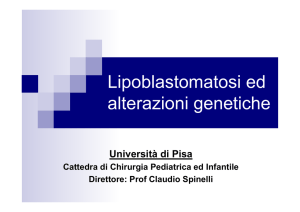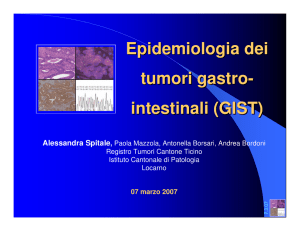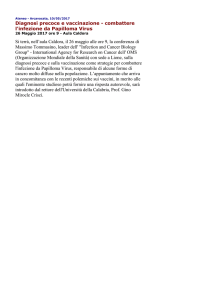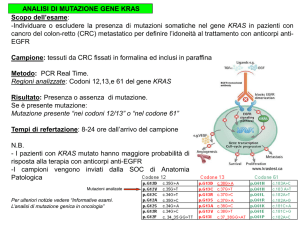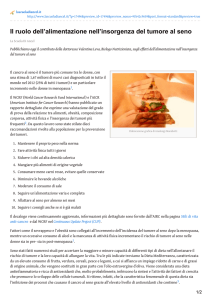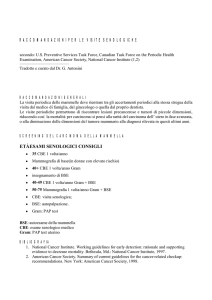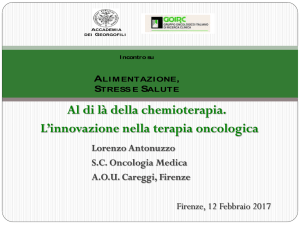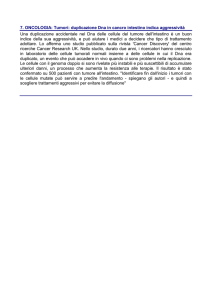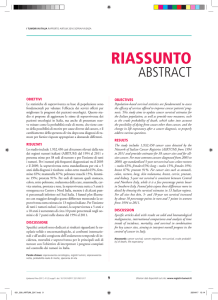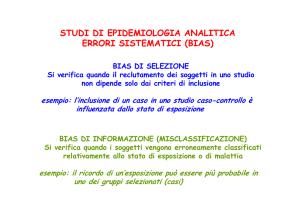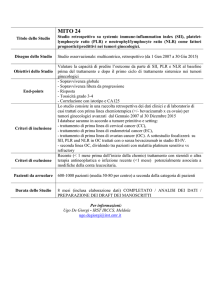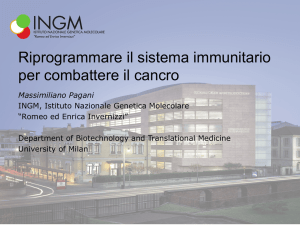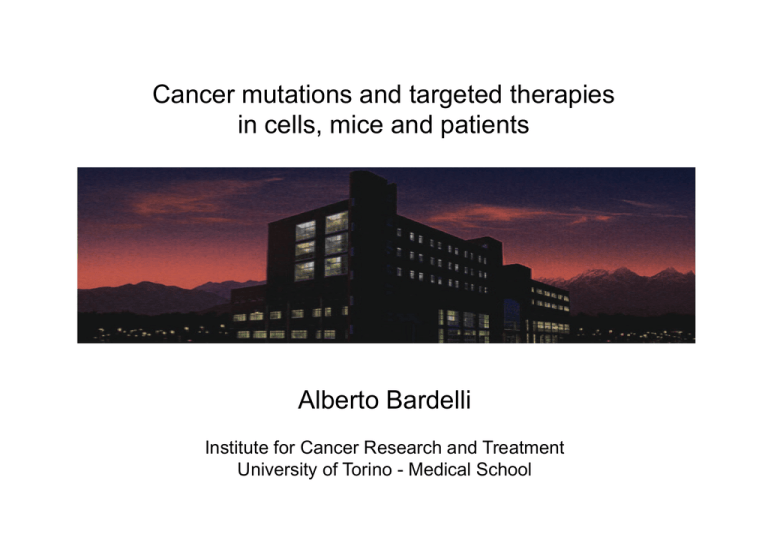
Cancer mutations and targeted therapies
in cells, mice and patients
Alberto Bardelli
Institute for Cancer Research and Treatment
University of Torino - Medical School
Le analisi molecolari sui tumori umani, oggi possibili
grazie al completamento del progetto genoma , stanno
portando alla definizione di un nuovo paradigma:
“Il trattamento individualizzato del paziente
oncologico sulla base del profilo molecolare
delle sue cellule neoplastiche”
“Cancer is, in essence, a genetic disease.
Although cancer is complex, and
environmental and other nongenetic
factors clearly play a role in many stages
of the neoplastic process, the
tremendous progress made in
understanding tumorigenesis in large part
is owing to the discovery of the genes,
that when mutated, lead to cancer.”
Bert Vogelstein (1988)
NEJM 1988; 319:525-532.
Bert Vogelstein
Ken Kinzler
Johns Hopkins University
Medical School
Victor Velculescu
The Howard Hughes
Medical Institute
Argomenti
•! Il cancro: una malattia dei geni
•! Le cause del cancro
•! I geni del cancro
•! Le terapie personalizzate
IL CANCRO NEL 2009
27 milioni
Nuovi casi
17 milioni
Decessi
75 milioni
Pazienti
Il cancro: una malattia genetica
Prima mutazione
(pu˜ essere ereditata)
Seconda mutazione
Il cancro è una malattia dei geni
Il cancro!!..
PRINCIPALI CAUSE DELL’ INSORGENZA
DEI TUMORI UMANI
Cosa danneggia i nostri geni?
Agenti chimici
Ereditˆ
Agenti fisici
DNA
DNA
Virus
I NOSTRI GENI “INVECCHIANO”
Età
Incidenza tumori
La nostra vita media si allunga
progressivamente
The population pyramid for China unfolds over a 100
(1950-2050) year period and the aging of the
population becomes quite obvious.
For the period 1950 to 1995 the pyramid is based on population estimates
of the UN Population Division; the data for 2000 to 2050 are from the most
recent medium variant UN population projection.
CANCER Ð WORLDWIDE BURDEN 2005
11 million
New Cases
6.8 million Deaths
25 million
Living with Cancer
CANCER Ð WORLDWIDE BURDEN-2030
27 million
New Cases
17 million Deaths
75 million
Living with Cancer
Prevenzione
Prevenzione
Prevenzione
Argomenti
•! Il cancro: una malattia dei geni
•! Le cause del cancro
•! I geni del cancro
•! Le terapie personalizzate
Il cancro è una malattia dei geni
I geni del cancro
•! THE HUMAN GENOME PROJECT
•! THE CANCER GENOME PROJECT(s)
THE HUMAN GENOME PROJECTs
Initial sequencing and analysis of the human genome
Nature 409, 2001
The Genome International Consortium
The Sequence of the Human Genome
Science 2001
Celera
THE CANCER GENOME PROJECT
THE CANCER GENOME PROJECT
Il genoma umano = Enciclopedia
Il genoma umano = 46 cromosomi
Il genoma umano = Enciclopedia
Courtesy of Bert Vogelstein
Il genoma umano
•! Ogni gene è una singola pagina che
contiene circa ~1500 caratteri
Courtesy of Bert Vogelstein
Il genoma umano
•! Ogni gene è una pagina che contiene
circa 1500 caratteri
•! I geni sono organizzati in libri (cromosomi) di
circa 1000 pagine ognuno
Courtesy of Bert Vogelstein
Il genoma umano
•! Ogni gene è una pagina che contiene circa
~1500 caratteri
•! I geni sono organizzati in libri (cromosomi) di
circa 1000 pagine ognuno
•! Il Genoma è una enciclopedia di 46 libri
(23 libri da ogni genitore)
Courtesy of Bert Vogelstein
Il genoma tumorale = Enciclopedia
•! 44 pagine con errori di ortografia
•! 11 pagine mancanti
•! 8 pagine duplicate
Il genoma tumorale = Enciclopedia
Courtesy of Bert Vogelstein
In realtà è più semplice di cosi
Solo una piccola parte delle mutazioni/errori
di ortografia sono coinvolti nello sviluppo dei tumori
Courtesy of Bert Vogelstein
Colorectal cancer
>1 million cases/year about
50% with metastatic disease
212.000 deaths/year in Europe
Parkin DM, et al. CA Cancer J Clin 2005;55:74Ð 108; Boyle P, Ferlay J. Ann Oncol 2005;16:481Ð 488;
www.future-health-2007.com
Colon cancer in Italy
35.000 cases/year
About 17.000 with metastases
Mutational landscapes of cancer genomes:
Mountains and Hills
PIK3CA
TP53
PIK3CA
TP53
APC
KRAS
Bardelli et. al., Science: 300 (2003)
Wood et al., Science : 318 (2007)
•! Cancer gene mountains and EGFR targeted
therapies in colorectal cancers
•! Parallel clinical trials in cells, mice and
patients
Cancer mutations and targeted therapies
Mutation X
Drug Y
Anti EGFR therapy and colorectal cancer
Cetuximab or
Panitumumab
Adapted from Ciardiello F. and Tortora G. NEJM 2008;358:1160-74
Who will respond to EGFR
targeted therapies ?
Responders (15-20%)
Non-Responders
2004
Mutations in the EGFR signalling pathway predict
response to antibodies targeting the EGFR
EGFR
Moroni et al., Lancet Oncology 2005
Benvenuti et al., Cancer Research. 2007
K-Ras
Di Nicolantonio et al., J Clin Oncol. 2008
Sartore-Bianchi A et al., Cancer Res 2009
Siena,Di Nicolantonio and Bardelli JNCI 2009
SOS
Grb2
Shc
MEK
PI3K
PTEN
Bardelli and Siena J Clin Oncol 2010
De Roock, Martini et al Lancet Oncology 2010
B-Raf
DUSPs
MAPK
PDK
Di Nicolantonio, Arena et al., JCI 2011
De Roock, Di Nicolantonio et al, JAMA 2011
S6K
AKT
GSK
Responder (15%)
KRAS-NRAS mutated (35-45%)
BRAF mutated (8%)
PIK3CA mutated and/or
PTEN loss (15-20%)
KRAS/PIK3CA mutated
BRAF/PIK3CA mutated
20-25% ? (quadruple negative)
Bardelli and Siena, J Clin Oncol 2010
Not all mutations are created equal......
KRAS mutations
Smith G, et al., British Journal of Cancer (2010), 1 Ð 11
GEP
GDP
GDI
GDP
GTP
RAS
RAS
(inactive)
Farnesyl
Geranylgeranyl
GTP
Pi
GAP
(active)
Effectors:
RAF/MAPK/ERK
PI3K/AKT
The role of individual KAS mutations in CRCs
G12 (27.2%)
OTHER
G13(5.8%)
D
V
C
S
A
R
D
C
V
11.5%
7.5%
3.0%
2.2%
2.2%
0.4%
5.6%
0.18%
0.02%
1%
Not all KRAS mutations are created equal
Colorectal cancers
Not all KRAS mutations are created equal
Pancreatic cancers
KRAS mutations:
clinical results from cetuximab treated mCRC
Moroni Lancet Oncol 2005 n=31
Response rate:
analysis of 8 studies
available in PubMed or
from ASCO
Li• vre Clin Cancer Res 2006 n=30
Di Fiore Br J Cancer 2007 n=59
Frattini Br J Cancer 2007 n=27
Benvenuti Cancer Res 2007 n=48
Khambata-Ford J Clin Oncol 2007 n=80
De Roock ASCO Proc 2007 n=37
RAS mutated (7.0%)
Finocchiaro ASCO Proc 2007 n=81
RAS mutated (43.9%)
wt (93.0%)
Responders (n=82)
wt (56.1%)
Non-Responders (n=312)
Molecular bases of G12V versus G13D
mediated resistance to cetuximab in
cellular and animal models
Experimental design
Cellular model
Gene targeting (Knock-in approach)
KRAS: G12D, G12V, G12C, G12A, G12S, G12R, G13D
BRAF: V600E, PIK3CA: E545K (exon 9), H1047R (exon 20)
Biochemical validation (pathway activation)
Measure drug response
NotI
A
ITR
G12V (G35>G/T)
LoxP
P
Neo
LoxP
ITR
AAV-KRas-12V
NotI
ITR
NotI
G13D (G38>G/A) NotI
LoxP
P
Neo
LoxP
LoxP
ITR
AAV-KRas-13D
Knock-in G12V
Homologous recombination (or G12D / G12C)
B
KRAS WT CRC cells
C
SW48 KRAS WT
SW48 KRAS G12V
SW48 KRAS G13D
Knock-in G13D
KRAS G12V or G13D and
chemotherapy in cellular models
KRAS G12V and G13D and
ceruximab in cellular models
De Roock et al JAMA 2010
Knock-in G12V
Homologous recombination (or G12D / G12C)
KRAS WT CRC cells
Knock-in G13D
Cetuximab delays growth of SW48 tumor xenografts
Cetuximab does not affect growth of G12V tumors,
but inhibits the growth of G13D tumor xenografts
SW48 KRAS G12V
Start of treatment
SW48 KRAS G13D
Start of treatment
•! Cancer gene mountains and EGFR targeted
therapies in colorectal cancers
•! Parallel clinical trials in cells, mice and patients
Xenopatients: a preclinical platform
Mutation X
Drug Y
Xenopatients for pre-clinical trials
DNA, RNA and protein extraction,
FFPE blocks stored by the pathologist
Liver Met implanted
s.c. in NOD SCID mice
Marker A
Drug X
Patient undergoing liver
metastasectomy of CRC
Using this approach 180 samples were
succesfully engrafted since Oct 2008
A. Bertotti & L. Trusolino,
Molecular Oncology, IRCC
Marker B
Expansion
Trial
Drug Y
The doctorÕ s perspective
Royal Mail Stamp Issue 25 February 2003
The patientÕ s perspective
Molecular Genetics Lab:
Federica Di Nicolantonio
Sabrina Arena
Miriam Martini
Emily Crowley
Elisa Scala
Carlotta Cancelliere
Sebastijan Hobor
Davide Zecchin
Simona Lamba
Michela Buscarino
Livio Trusolino
Josep Tabernero
Sabine Tejpar
Salvatore Siena
Andrea Sartore Bianchi
Marcello Gambacorta
Andrea Bertotti
[email protected]

